OP10L
Anti-c-Myc (Ab-1) Mouse mAb (9E10)
lyophilized, clone 9E10, Calbiochem®
About This Item
Produtos recomendados
fonte biológica
mouse
Nível de qualidade
forma do anticorpo
purified antibody
tipo de produto de anticorpo
primary antibodies
clone
9E10, monoclonal
Formulário
lyophilized
não contém
preservative
reatividade de espécies
rat (weakly), human, mouse (weakly)
fabricante/nome comercial
Calbiochem®
condição de armazenamento
OK to freeze
Isotipo
IgG1
Condições de expedição
ambient
temperatura de armazenamento
2-8°C
modificação pós-traducional do alvo
unmodified
Informações sobre genes
human ... MYC(4609)
mouse ... Myc(17869)
rat ... Myc(24577)
Descrição geral
Imunogênio
Aplicação
Frozen Sections (2-10 µg/ml)
Immunoblotting (1-5 µg/ml, see application references)
Immunofluorescence (1-5 µg/ml or use Cat. No. OP10F)
Immunoprecipitation (1 µg/sample)
Chromatin Immunoprecipitation (5 µg/ml, see application references)
Paraffin Sections (not recommended)
Advertência
forma física
Reconstituição
Nota de análise
HT1080 cells
HL-60 cells or lung carcinoma
Outras notas
Cole, M.D. 1986. Ann. Rev. Gen.20, 361.
Nisen, P.D., et al. 1986. Cancer Res.46, 6217.
Nau, M.M., et al. 1985. Nature318, 69.
Persson, H., et al. 1984. Science225, 687.
Alitalo, K., et al. 1983. Proc. Natl. Acad. Sci. USA80, 1707.
Informações legais
Não está encontrando o produto certo?
Experimente o nosso Ferramenta de seleção de produtos.
Código de classe de armazenamento
11 - Combustible Solids
Classe de risco de água (WGK)
WGK 1
Certificados de análise (COA)
Busque Certificados de análise (COA) digitando o Número do Lote do produto. Os números de lote e remessa podem ser encontrados no rótulo de um produto após a palavra “Lot” ou “Batch”.
Já possui este produto?
Encontre a documentação dos produtos que você adquiriu recentemente na biblioteca de documentos.
Nossa equipe de cientistas tem experiência em todas as áreas de pesquisa, incluindo Life Sciences, ciência de materiais, síntese química, cromatografia, química analítica e muitas outras.
Entre em contato com a assistência técnica






